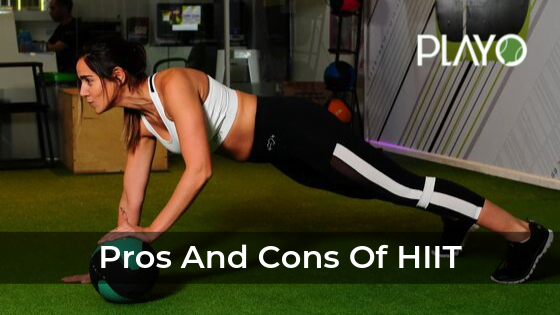By now HIIT (high-intensity interval training) is something most of you would’ve known as the latest growing trend in the fitness circle, regardless of whether you are a regular gym-goer or not. Faster weight loss and toning achieved in short intervals while spending less time than you’d typically spend at the gym doing steady-state cardio, there’s no denying why HIIT has made its fan base. It has been more popular amongst busy people who want fast output with less input time.
While there’s no denying the benefits, jumping into a HIIT routine mandatorily requires your body to get prepared for enduring such stress and you need to realise that it takes quite a while to get there. That keeping in mind, there are both good and bad sides of this program that need to be taken into consideration before jumping on the bandwagon.
Pros of high-intensity interval training:
#1. It is time-efficient
The best part about anything you indulge in is reaping benefits in as less time as possible, more so with a workout. Especially when it comes to people with tight schedules, HIIT works well because just about a 30 to 45 minutes session is more than enough to burn truckloads of fat.
#2. It offers versatility
More often than not, many people are likely to find conventional cardio boring. You can merge strength, cardio and core training all into one and experiment with different variations in every session. Be it squat thrust to frog jumps, a plank with a row or a dumbbell goblet squat you can pretty much mix up anything and figure out what works for you the best.
#3. Your metabolic rate stays high till hours after
According to some researchers, HIIT increases your metabolism for hours post exercising more than jogging and weight training. This is called the afterburn effect or EPOC (excess post-exercise oxygen consumption), a higher rate of oxygen intake following a hefty workout session.
#4. No gym space, no problem
Another great quality about HIIT is its adaptability, meaning you can do it virtually anywhere from your living room to a park. Weights and machinery are definitely something you can incorporate but since they aren’t absolutely vital, it works well for you. Indulging in a combination of floor exercises like burpees, pushups and mountain climbers doesn’t need a gym.
Cons of high-intensity interval training
#1. It is not for everyone
First, HIIT requires you to have a basic level of fitness in order to take part. If you’re not used to working out with at least a moderate intensity level, it can cause excessive stress on the heart, muscles and joints. Secondly, not everyone will enjoy it as no two bodies are alike.
#2. You can easily burn out due to overtraining
Let’s put it out there, HIIT is demanding. This high intensity of exercise can require more mental and physical strength putting you at an increased risk of overtraining or burn out. Taking at least one rest day between HIIT sessions will ensure a speedy recovery. It would also give your mind and body a much-needed break.
#3. It can cause injuries
Fast pace can cause you to perform certain exercises in an incorrect form especially weighted ones. This brings in risks for injuries and stress on the connective tissues. It is imperative that you make sure your HIIT sessions are supervised by a trainer.
So make sure you know what you’re doing when it comes to HIIT, all the good, bad and ugly. Just because it is a trend, doesn’t mean you need to go along if it isn’t working out for you.





0 Comments